This core provides state-of-the-art instrumentation and methodology for the determination of energy balance and body composition in small animals. This includes the measurement of energy expenditure, via indirect calorimetry; food intake, activity, and core body temperature. Body composition techniques involve both ex vivo, via chemical carcass analysis and microcomputed tomography and in vivo methods using dual-energy x-ray absorptiometry (DXA), and quantitative magnetic resonance (QMR).
Services
Chemical carcass analysis has long been the “gold standard” for the determination of body composition and the SAPC still uses this as the standard for validating new instruments and techniques. Although useless for longitudinal studies, it is useful when an investigator’s animals have been killed and frozen. The carcasses/samples are dried (for water content), fat extracted and then burnt at 600 degrees Celsius to get ash content.
Dual-energy x-ray absorptiometry (DXA) uses two different X-rays to measure fat, soft-lean tissue, and bone in vivo. Animals are anesthetized (Isoflurane) and placed prostrate in the imaging area with the front and back legs extended away from the body. The DXA machines in the core can measure animals from approximately 15g to 65g and also from 250g to 120kg. A typical scan takes approximately 5 minutes.
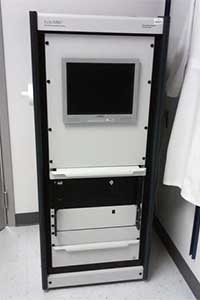 Rat QMR instrument
Rat QMR instrument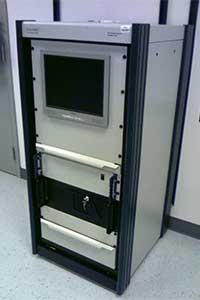 3-in-1 quantitative magnetic resonance (QMR) instrument
3-in-1 quantitative magnetic resonance (QMR) instrument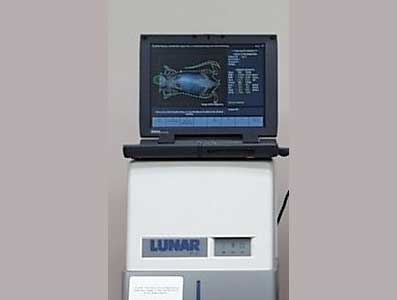 Lunar PIXImus small animal DXA
Lunar PIXImus small animal DXAQuantitative magnetic resonance (QMR) is used to measure fat and lean mass as well as the water content in vivo with no need for anesthesia. The core is able to use QMR to measure body composition in groups of 10 fruit flies, tissue samples (1g-10g), mice (approximately 15g to 80g), and rats (up to 900g). Scans take approximately 2 minutes for mice and rats, up to 9 minutes for the fruit flies.
Micro-computed tomography can three-dimensionally image excised bones up to 36mm in diameter and 80 mm in length. Six µm resolution is possible in bones of less than 12mm diameter, with a maximum of 18 µm resolution for the samples scanned in the largest holders (36mm diameter). Information on the trabecular bone (density, volume, trabecular number, separation, and thickness) and cortical bone (volume, density, cortical thickness, and moments of inertia) can be obtained from the scans. Bones that are fixed in formalin or other preservatives can be imaged prior to more destructive analyses like histomorphometry. Soft tissues may be able to be imaged with appropriate contrast staining - please contact to discuss.
The TSE indirect calorimetry system collects data on oxygen consumption, carbon dioxide production, food consumption, and locomotor activity in up to 8 animals at a time. Mice are acclimated for 2 days, before the measurement period of at least one day. Total and resting energy expenditure is calculated for the measurement period. Locomotor activity is measured in the x-y planes using a system of infra-red beams surrounding the cage and is collected continuously during the measurement. Data on meal size and the timing of meals can be obtained from the food hoppers attached to transducers. Body composition is always assessed after the measurement period, using QMR, to allow for the energy expenditure measurements to be normalized appropriately for body composition.
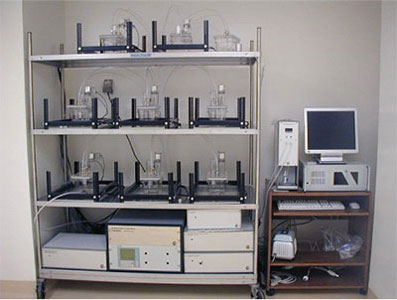 TSE Lab animal system
TSE Lab animal system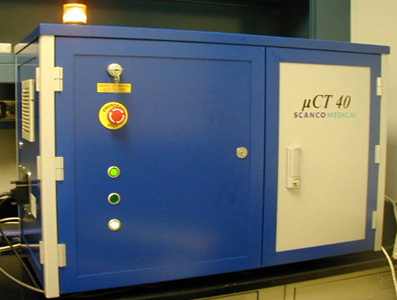 Scanco µCT40
Scanco µCT40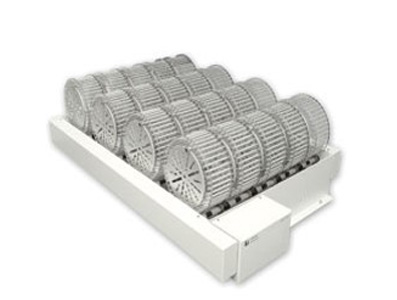 Forced running wheels
Forced running wheelsThe E-Mitter transponder/receiver system comprises of battery-free transponders that are implanted into the abdominal cavity and a receiver base that the cage sits on. The transponders transmit information on core body temperature via the base to a computer. Locomotor activity is assessed as the mouse moves over the top of the receiver. Thus activity and body temperatures can be measured continuously while the animal is in its home cage.
The core currently has two-wheel running systems for mice and rats in which the wheel in the cage sends information to a computer as to the number of revolutions and the timing of the revolutions. This allows investigators to assess voluntary physical activity.
For investigators interested in the effect of forced exercise, the core has a system of running wheels on a rolling bed, for which the speed and time of the exercise can be determined and changed by the investigator.
Digestive efficiency can be assessed by measuring food intake, the weight of feces produced and then measuring the energy content of both using a bomb calorimeter. By measuring the weight of food consumed and the energy content of that food, energy intake can be calculated. The weight and energy content of the feces can be measured to give an estimate of energy lost, and together these give an indication of how much energy the animals are absorbing from the food.
Resources
- 2 DXA systems to measure in vivo body composition in animals from 15g to 65g and 250g to 120kg.
- 2 QMR systems to measure in vivo body composition in mice and rats (or similar sized animals)
- 8-cage TSE indirect calorimetry system with oxygen and carbon dioxide analyzers, and infra-red beam break activity system
- 16-cage acclimation system for the indirect calorimetry system
- 2 isoflurane anesthesia carts
- 32 wheel running cages: 16 for rats, 16 for mice
- 20 walking wheel forced exercise system (Lafeyette Instruments)
- 1 Scanco µCT40 micro-computed tomography system
- 12 receiver bases; 12 PDT-4000 (rats) and 20 G2 (mice) implantable transponders to measure temperature and activity in home cages.
- 1 bomb calorimeter for the measurement of the energy content of food and feces
- 2 drying ovens
- 12 Soxhlet fat extractors
- 1 muffle furnace
- 3 industrial blenders
- 3 environmental chambers to measure indirect calorimetry of mice at different temperatures and light cycles
Fees
| Service | Cost |
|---|---|
| uCT (per hr) | $80.00 |
| DXA | $9.00 |
| QMR - Echo QMR 3-in-1 (mouse) | $10.00 |
| QMR - Echo QMR rat (rat) | $11.00 |
| Indirect Calorimetry (per 8 mice for 5 days) | $500.00 |
| Indirect Calorimetry (per 8 rats for 5 days) | $600.00 |
| Wheel running (per day) | $4.00 |
| Bomb calorimetry | $35.00 |
| Carcass analysis (mouse) | $35.00 |
| Carcass analysis (rat) | $50.00 |
Contact
Daniel Smith, Ph.D.
Assistant Professor
Department of Nutrition Sciences
Phone: (205) 934-4086
Email:
Maria S. Johnson, Ph.D.
Assistant Professor
Department of Nutrition Sciences
Phone: (205) 934-4008
Email: